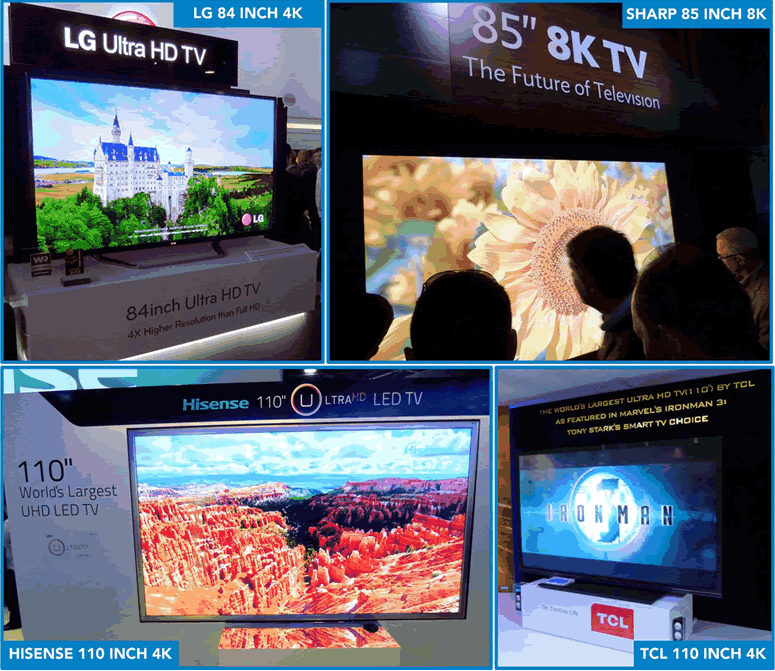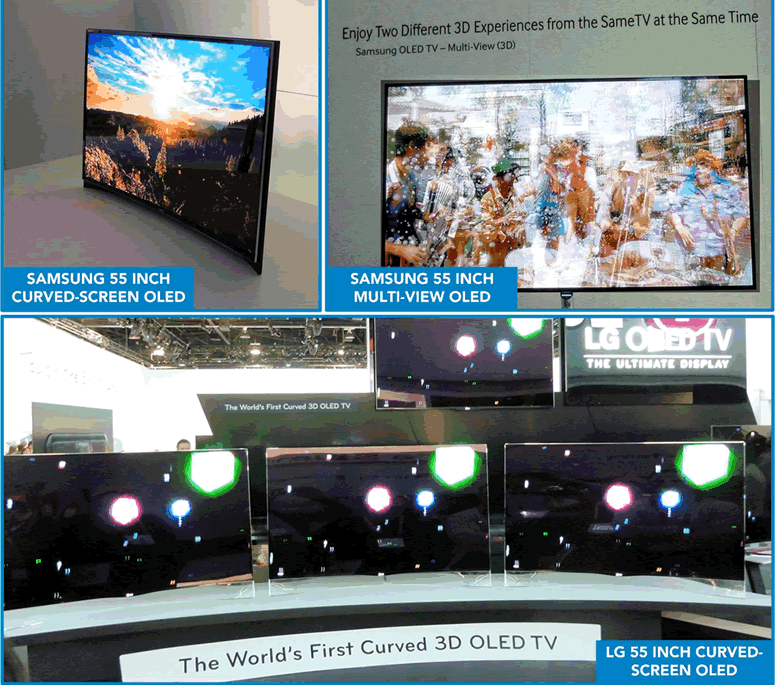Here's some of the TV industry highlights from CES:
UltraHDTV (UHD) & displays - The industry's settled on the name (and standards) for the next improvement in video screen resolution. This step has actually been in use for a while in the movie industry as 4K, as older analog film stock is increasingly digitized at 4K (3840x2160 P) or 8K resolutions (7690x4320 P) prior to digital processing (cleaning, color correction, etc.) of the movie to create the digital archive version - which is then downconverted to HDTV or NTSC formats and resolutions for home video or licensing.
However, until this year there were only a few 4K displays available to consumers, and those were extremely expensive. This year, in contrast, most of the major TV set manufacturers displayed new consumer UHD displays at CES. Along with 4K displays running from 20" to 110" were several promising 4K 3-D, and a couple of consumer 8K sets (including the 85" 8K from Sharp displayed to the side). However, there remains the problem of a lack of 4K or 8K programming sources.
The new 4K sets, and a few BluRay players, can upconvert current signals to 4K, but at this time there's little content available to consumers in native 4K formats.
NHK has been experimenting with higher resolution cameras, and transmitting the resulting 4K content over the Internet for several years. South Korea reportedly has an experimental test channel for UHD, and the BBC filmed some of last summer's Olympics in 4K and distributed the content to several public 4K displays. More recently, Red Digital Cinema Camera Company, a prominent digital film camera manufacturer, announced the availability of a player capable of sending a native 4K signal to a single 4K display. And NHK announced it will be demonstrating 8K broadcasting (7680x4320P video format that provides 16 times more pixels than HDTV, and a 22.2 multichannel
audio system that produces a 3D sound space for viewers located anywhere
within a large viewing area) in a special theater at the NAB Show in a few months. A few cable MSOs have indicated an interest in offering 4K channels, and Sony is promising a 4K movie downloading service to be launched this summer.
Organic LED (OLED) displays - I think these have been "hot prospects" for almost a decade, and certainly the technological potential of OLED displays (environmentally friendly, high contrast, and the potential for flexible screens and unlimited sizes) is worthy of the hype. The problem's been ramping the theoretical technology up to commercially viable manufacturing levels. (And don't confuse true LED or OLED displays with flatscreen LCD screens using LED for backlighting - which is what most TVs marketed as "LEDs" really are).
OLED's potential as mass consumer TV displays seems to still be sometime in the future (promised availability keeps being pushed back), but there were a some leading-edge options on display at CES. Samsung displayed a 55-inch "multiview" OLED that displayed two separate programs on the same screen (upper right in image to the side). It builds on the 3-D approach of using active viewing glasses to distinguish the two signals, allowing the viewer to choose which one to watch. The higher contrast and faster signal switching of OLEDs allows this to work on very different program contents (in 3-D, they're basically the same image with slight offsets in perspectives). For it's part, LG displayed a curved OLED 3-D display. And Panasonic offered their first 4K OLED display. However, Sony took a hit when it's 4K OLED offering failed to work during their big press conference at CES (see story and video here), although they did get it to work later in their booth.
The major set manufacturers once again promised that consumer OLED sets would be available within the year, but as I mentioned, they've been saying that for a long time, with little actually to show.
Touch-screen computing offerings also went for the Wow factor, with a big push from Microsoft and its Windows 8 operating system. Samsung was there with a 24-inch touchscreen monitor, while Panasonic displayed a 20-inch tablet offering 4K resolution. Higher resolution screens was an emphasis on most traditional tablets on display. New offerings also seemed to focus on splitting the tablet market - with many stressing computing power and compatibility, while others focus on the devices' ability to handle media content and/or gaming.
And for those not into big and beautiful, there were the Mobile DTV offerings (principally DyleTV). These don't refer to watching TV on mobile devices through traditional TV tuners and broadcast stations, or the ability to download and watch videos from the Internet. Several groups are experimenting with using parts of the current broadcast spectrum to broadcast specially formatted (lower resolution and reframed for smartphone screen orientations) television signals. While DyleTV is already offering access to some local TV channels in some markets, Mobile DTV has a way to go before its consumer-ready (and consumer-friendly).
Sources - Display Technology Takes Center Stage at 2013 International CES, TV TechCheck
NHK to do First 8K U.S. Broadcast Demo at NAB Show, TV Technology
10 Best Tablets of CES 2013, Laptop Mag




No comments:
Post a Comment